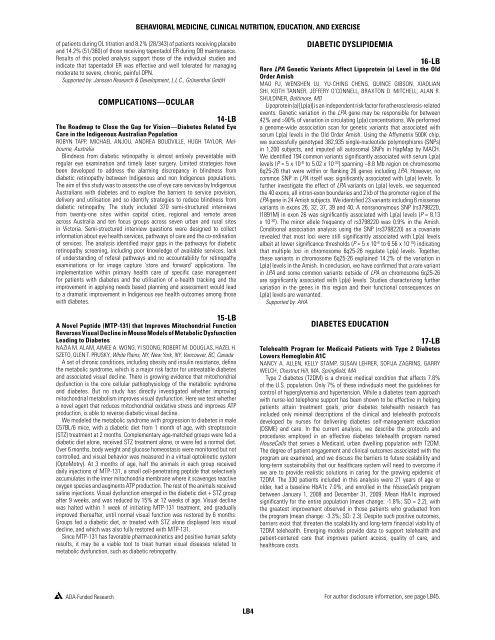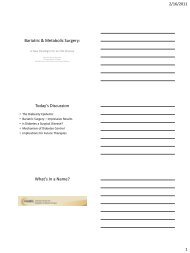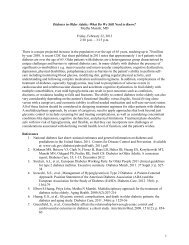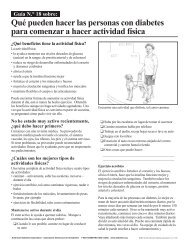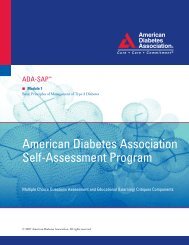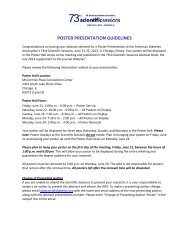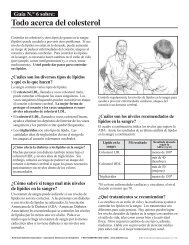A JournAl of the AmericAn DiAbetes AssociAtion
A JournAl of the AmericAn DiAbetes AssociAtion
A JournAl of the AmericAn DiAbetes AssociAtion
- No tags were found...
You also want an ePaper? Increase the reach of your titles
YUMPU automatically turns print PDFs into web optimized ePapers that Google loves.
Behavioral Medicine, Clinical Nutrition, Education, and Exercise<strong>of</strong> patients during OL titration and 8.2% (28/343) <strong>of</strong> patients receiving placeboand 14.2% (51/360) <strong>of</strong> those receiving tapentadol ER during DB maintenance.Results <strong>of</strong> this pooled analysis support those <strong>of</strong> <strong>the</strong> individual studies andindicate that tapentadol ER was effective and well tolerated for managingmoderate to severe, chronic, painful DPN.Supported by: Janssen Research & Development, L.L.C., Grünenthal GmbHComplications—Ocular14-LBThe Roadmap to Close <strong>the</strong> Gap for Vision—Diabetes Related EyeCare in <strong>the</strong> Indigenous Australian PopulationROBYN TAPP, MICHAEL ANJOU, ANDREA BOUDVILLE, HUGH TAYLOR, Melbourne,AustraliaBlindness from diabetic retinopathy is almost entirely preventable withregular eye examination and timely laser surgery. Limited strategies havebeen developed to address <strong>the</strong> alarming discrepancy in blindness fromdiabetic retinopathy between Indigenous and non Indigenous populations.The aim <strong>of</strong> this study was to assess <strong>the</strong> use <strong>of</strong> eye care services by IndigenousAustralians with diabetes and to explore <strong>the</strong> barriers to service provision,delivery and utilisation and so identify strategies to reduce blindness fromdiabetic retinopathy. The study included 370 semi-structured interviewsfrom twenty-one sites within capital cities, regional and remote areasacross Australia and ten focus groups across seven urban and rural sitesin Victoria. Semi-structured interview questions were designed to collectinformation about eye health services, pathways <strong>of</strong> care and <strong>the</strong> co-ordination<strong>of</strong> services. The analysis identified major gaps in <strong>the</strong> pathways for diabeticretinopathy screening, including poor knowledge <strong>of</strong> available services, lack<strong>of</strong> understanding <strong>of</strong> referal pathways and no accountability for retinopathyexaminations or for image capture ‘store and forward’ applications. Theimplementation within primary health care <strong>of</strong> specific case managementfor patients with diabetes and <strong>the</strong> utilisation <strong>of</strong> e-health tracking and <strong>the</strong>improvement in applying needs based planning and assessment would leadto a dramatic improvement in Indigenous eye health outcomes among thosewith diabetes.15-LBA Novel Peptide (MTP-131) that Improves Mitochondrial FunctionReverses Visual Decline in Mouse Models <strong>of</strong> Metabolic DysfunctionLeading to DiabetesNAZIA M. ALAM, AIMEE A. WONG, YI SOONG, ROBERT M. DOUGLAS, HAZEL H.SZETO, GLEN T. PRUSKY, White Plains, NY, New York, NY, Vancouver, BC, CanadaA set <strong>of</strong> chronic conditions, including obesity and insulin resistance, define<strong>the</strong> metabolic syndrome, which is a major risk factor for untreatable diabetesand associated visual decline. There is growing evidence that mitochondrialdysfunction is <strong>the</strong> core cellular pathophysiology <strong>of</strong> <strong>the</strong> metabolic syndromeand diabetes. But no study has directly investigated whe<strong>the</strong>r improvingmitochondrial metabolism improves visual dysfunction. Here we test whe<strong>the</strong>ra novel agent that reduces mitochondrial oxidative stress and improves ATPproduction, is able to reverse diabetic visual decline.We modeled <strong>the</strong> metabolic syndrome with progression to diabetes in maleC57BL/6 mice, with a diabetic diet from 1 month <strong>of</strong> age, with streptozocin(STZ) treatment at 2 months. Complementary age-matched groups were fed adiabetic diet alone, received STZ treatment alone, or were fed a normal diet.Over 6 months, body weight and glucose homeostasis were monitored but notcontrolled, and visual behavior was measured in a virtual optokinetic system(OptoMotry). At 3 months <strong>of</strong> age, half <strong>the</strong> animals in each group receiveddaily injections <strong>of</strong> MTP-131, a small cell-penetrating peptide that selectivelyaccumulates in <strong>the</strong> inner mitochondria membrane where it scavenges reactiveoxygen species and augments ATP production. The rest <strong>of</strong> <strong>the</strong> animals receivedsaline injections. Visual dysfunction emerged in <strong>the</strong> diabetic diet + STZ groupafter 9 weeks, and was reduced by 15% at 12 weeks <strong>of</strong> age. Visual declinewas halted within 1 week <strong>of</strong> initiating MTP-131 treatment, and graduallyimproved <strong>the</strong>reafter, until normal visual function was restored by 6 months.Groups fed a diabetic diet, or treated with STZ alone displayed less visualdecline, and which was also fully restored with MTP-131.Since MTP-131 has favorable pharmacokinetics and positive human safetyresults, it may be a viable tool to treat human visual diseases related tometabolic dysfunction, such as diabetic retinopathy.Diabetic Dyslipidemia16-LBRare LPA Genetic Variants Affect Lipoprotein (a) Level in <strong>the</strong> OldOrder AmishMAO FU, WENSHEN LU, YU-CHING CHENG, QUINCE GIBSON, XIAOLIANSHI, KEITH TANNER, JEFFERY O’CONNELL, BRAXTON D. MITCHELL, ALAN R.SHULDINER, Baltimore, MDLipoprotein (a) [Lp(a)] is an independent risk factor for a<strong>the</strong>rosclerosis-relatedevents. Genetic variation in <strong>the</strong> LPA gene may be responsible for between42% and >90% <strong>of</strong> variation in circulating Lp(a) concentrations. We performeda genome-wide association scan for genetic variants that associated withserum Lp(a) levels in <strong>the</strong> Old Order Amish. Using <strong>the</strong> Affymetrix 500K chip,we successfully genotyped 382,935 single-nucleotide polymorphisms (SNPs)in 1,200 subjects, and imputed all autosomal SNPs in HapMap by MACH.We identified 194 common variants significantly associated with serum Lp(a)levels (P = 5 x 10 -8 to 5.02 x 10 -33 ) spanning ~8.8 Mb region on chromosome6q25-26 that were within or flanking 26 genes including LPA. However, nocommon SNP in LPA itself was significantly associated with Lp(a) levels. T<strong>of</strong>ur<strong>the</strong>r investigate <strong>the</strong> effect <strong>of</strong> LPA variants on Lp(a) levels, we sequenced<strong>the</strong> 40 exons, all intron-exon boundaries and 2 kb <strong>of</strong> <strong>the</strong> promoter region <strong>of</strong> <strong>the</strong>LPA gene in 24 Amish subjects. We identified 23 variants including 6 missensevariants in exons 26, 32, 37, 39 and 40. A nonsynonymous SNP (rs3798220,I1891M) in exon 26 was significantly associated with Lp(a) levels (P = 8.13x 10 -30 ). The minor allele frequency <strong>of</strong> rs3798220 was 0.9% in <strong>the</strong> Amish.Conditional association analysis using <strong>the</strong> SNP (rs3798220) as a covariaterevealed that most loci were still significantly associated with Lp(a) levelsalbeit at lower significance thresholds (P = 5 x 10 -8 to 6.56 x 10 -15 ) indicatingthat multiple loci in chromosome 6q25-26 regulate Lp(a) levels. Toge<strong>the</strong>r,<strong>the</strong>se variants in chromosome 6q25-26 explained 14.2% <strong>of</strong> <strong>the</strong> variation inLp(a) levels in <strong>the</strong> Amish. In conclusion, we have confirmed that a rare variantin LPA and some common variants outside <strong>of</strong> LPA on chromosome 6q25-26are significantly associated with Lp(a) levels. Studies characterizing fur<strong>the</strong>rvariation in <strong>the</strong> genes in this region and <strong>the</strong>ir functional consequences onLp(a) levels are warranted.Supported by: AHADiabetes Education17-LBTelehealth Program for Medicaid Patients with Type 2 DiabetesLowers Hemoglobin A1CNANCY A. ALLEN, KELLY STAMP, SUSAN LEHRER, SOFIJA ZAGRINS, GARRYWELCH, Chestnut Hill, MA, Springfield, MAType 2 diabetes (T2DM) is a chronic medical condition that affects 7.8%<strong>of</strong> <strong>the</strong> U.S. population. Only 7% <strong>of</strong> <strong>the</strong>se individuals meet <strong>the</strong> guidelines forcontrol <strong>of</strong> hyperglycemia and hypertension. While a diabetes team approachwith nurse-led telephone support has been shown to be effective in helpingpatients attain treatment goals, prior diabetes telehealth research hasincluded only minimal descriptions <strong>of</strong> <strong>the</strong> clinical and telehealth protocolsdeveloped by nurses for delivering diabetes self-management education(DSME) and care. In <strong>the</strong> current analysis, we describe <strong>the</strong> protocols andprocedures employed in an effective diabetes telehealth program namedHouseCalls that serves a Medicaid, urban dwelling population with T2DM.The degree <strong>of</strong> patient engagement and clinical outcomes associated with <strong>the</strong>program are examined, and we discuss <strong>the</strong> barriers to future scalability andlong-term sustainability that our healthcare system will need to overcome ifwe are to provide realistic solutions in caring for <strong>the</strong> growing epidemic <strong>of</strong>T2DM. The 330 patients included in this analysis were 21 years <strong>of</strong> age orolder, had a baseline HbA1c 7.0%, and enrolled in <strong>the</strong> HouseCalls programbetween January 1, 2008 and December 31, 2009. Mean HbA1c improvedsignificantly for <strong>the</strong> entire population (mean change: -1.8%; SD = 2.2), with<strong>the</strong> greatest improvement observed in those patients who graduated from<strong>the</strong> program (mean change: -3.3%; SD: 2.3). Despite such positive outcomes,barriers exist that threaten <strong>the</strong> scalability and long-term financial viability <strong>of</strong>T2DM telehealth. Emerging models provide data to support telehealth andpatient-centered care that improves patient access, quality <strong>of</strong> care, andhealthcare costs.ADA-Funded ResearchFor author disclosure information, see page LB45.LB4


